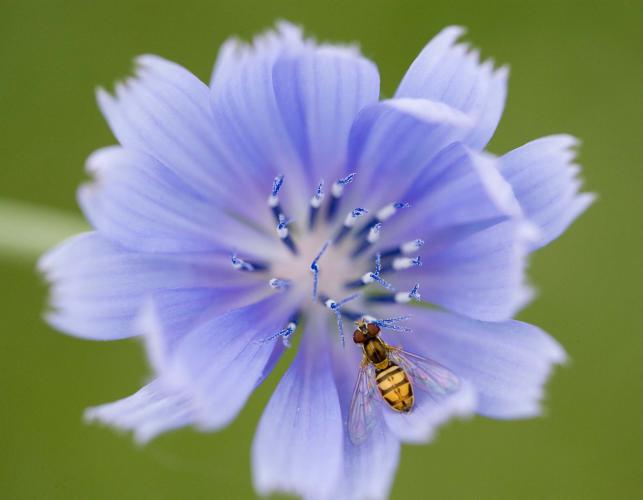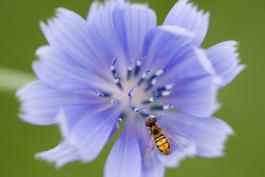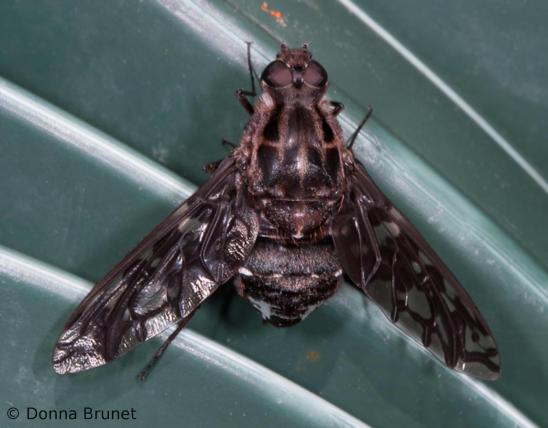
Harmless flies and valuable pollinators, flower flies (in the family Syrphidae) are incredibly convincing mimics of bees, wasps, and yellowjackets. Coloration usually involves yellow, orange, or red plus black or brown, often with stripes or other patterns to mimic the warning coloration of bees or wasps. The bee mimics are fuzzy; the wasp and yellowjacket mimics are not. Syrphids (pronounced "surfids") are very common. They do not bite or sting. Recognize them as true flies by their single pair of wings, short antennae, and flylike compound eyes. This large group of true flies are famous for visiting flowers, hovering around them and intimidating people who think they might sting.
Larvae vary. Like the larvae of other flies, they are all technically maggots, but the different lifestyles involve different shapes. Larvae that live in polluted aquatic habitats have a remarkably long, tail-like anal breathing tube that reaches up to the water surface like a snorkel; these aquatic larvae are called "rat-tailed maggots." The syrphid larvae that eat aphids have a more typical maggot shape and are often greenish; and those that live in ant or wasp nests are flattened ovals.
Similar species: Although there are several other groups of true flies that mimic bees and wasps (including bee flies, robber flies, and many more), entomologists use details of wing venation and antenna structure to separate these families and genera with assurance. The rest of us compare photographs and illustrations in field guides to try identify these insects! If you are simply able to distinguish a syrphid fly from a bee or a wasp, pat yourself on the back.
Length: most are ¼ to ¾ inch, but this is a large and diverse family, with much variation.
Statewide.
Habitat and Conservation
Being associated with flowers, syrphids are commonly seen in gardens and among wildflowers in pastures, prairies, roadsides, and other open areas where flowers abound. Many are important pollinators. Their resemblance to members of the bee and wasp family undoubtedly helps them avoid would-be predators.
Food
Adult flower flies take nourishment from the flowers they visit, taking nectar, pollen, or both. The larvae of this diverse family of flies vary quite a bit. Most are predators of other insects, with many preying on aphids and other plant-sucking bugs. Others eat organic materials from decaying plant or animal matter, such as wet wood, rotting vegetation, or carrion, or detritus in polluted aquatic habitats, or dung. Some live in ant or wasp nests.
Status
Flower flies might look capable of stinging, but they are harmless to people and are valuable as pollinators.
Life Cycle
Like butterflies, bees, and beetles, all true flies undergo complete metamorphosis, progressing from egg to a caterpillar or grublike larva, then pupating and emerging as a winged, sexually mature adult that bears little resemblance to the larval stages. Most of the eating and growing is done during the larval stages, while those in the adult stage focus primarily on mating and egg-laying. As with most other insects, the lives of most individuals end with the hard freezes of late fall, while pupae and other stages overwinter to emerge in spring.
Human Connections
Syrphids are considered beneficial insects by gardeners, who often plant flowers near their vegetables to attract the syrphids.
Flower flies do not bite or sting.
Flower flies play a role in pollination and many help to reduce the numbers of aphids and other insects injurious to crops or garden plants. They are a useful nontoxic biocontrol agent for pests of vegetable crops, as they prey on the larvae of insects that transmit plant viruses such as curlytop.
Oldtime Ozarkers paid close attention to these flies, which they called "news bees" or "good news bees." If a yellow news bee was flying around one's head, it meant that good news was on the way. However, if a black news bee was hanging around, it meant bad news was imminent.
Ecosystem Connections
It is clear that syrphids play a big role in flower pollination, with much variation regarding the particulars. Some syrphid species are generalists, visiting many kinds of flowers, while others visit only certain types of flowers. They may not carry as much pollen as a bee does, but they seem to work faster, making more visits.
There is an interesting case of a species of Asian orchid that emits a scent similar to the alarm pheromone of aphids, which apparently draws syrphids near that end up pollinating them.







































